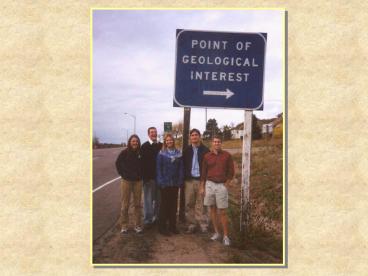Inuksuk - Nunavut, Canada - PowerPoint PPT Presentation
Title:
Inuksuk - Nunavut, Canada
Description:
STRESS is the force applied to a rock. If rocks are stressed enough, they will DEFORM. ... COMPRESSIONAL STRESS Occurs at convergent plate boundaries. – PowerPoint PPT presentation
Number of Views:91
Avg rating:3.0/5.0
Title: Inuksuk - Nunavut, Canada
1
(No Transcript)
2
Inuksuk - Nunavut, Canada
3
Geneviève Hsueh
4
GEOLOGIC TIME SCALE
Organizes all of Earth history into blocks of
time utilizing significant geologic
events. Preliminary subdivisions were done in the
18th and 19th centuries using relative dating
techniques. 20th century allowed determination of
numerical ages. Used all the numerical dating
techniques to do this.
5
GEOLOGIC TIME SCALE
Subdivisions of Time Eons Eras Periods Epoc
hs
None last equal intervals of time. Based on
events.
6
Mountains and earthquakes illustrate the energy
and power of plate tectonics. Produces large
mountain ranges such as the Rockies, Alps,
Himalaya and Appalachians. We also observe rocks
that have been bent or folded. Focus on the
geologic processes that deform the Earths crust
STRUCTURAL GEOLOGY.
7
Mt. Everest
Longs Peak, CO
8
STRESSING AND STRAINING ROCKS
Plate movement applies powerful forces to
rocks. Converging, diverging and sliding rocks
subject their margins to powerful
stresses. STRESS is the force applied to a
rock. If rocks are stressed enough, they will
DEFORM. DEFORMATION alters the shape and/or
volume of the rocks. This change is called
STRAIN.
9
STRESSING AND STRAINING ROCKS
Rocks can be stressed in three ways. 1.
TENSIONAL STRESS Occurs at divergent plate
boundaries. Thins crust vertically and lengthens
crust laterally.
10
STRESSING AND STRAINING ROCKS
2. COMPRESSIONAL STRESS Occurs at convergent
plate boundaries. Crumples rock, thickens rock
vertically and shortens rock laterally.
11
STRESSING AND STRAINING ROCKS
3. SHEAR STRESS Occurs at transform
boundaries. Rocks forced past each other in
parallel, but opposite directions.
12
TYPES OF DEFORMATION
ELASTIC DEFORMATION
STRESS is applied, released and rock returns
to original shape and volume. Material is not
DEFORMED. If stressed to a point where the
material doesnt resume original shape and
volume, the rock is deformed. Point at which this
occurs is the ELASTIC LIMIT. Pressure and
temperature when stress is applied
also determine how rocks deform at the elastic
limit.
13
TYPES OF DEFORMATION
ELASTIC DEFORMATION
Rocks subjected to stress at LOW temperature and
LOW pressure tend to BREAK. Causes the bonds
between atoms to break. Breaking in rocks is
called BRITTLE FAILURE.
14
TYPES OF DEFORMATION
PLASTIC or DUCTILE DEFORMATION
Rocks subjected to stress at HIGH temperature and
HIGH pressure tend to BEND, resulting
from PLASTIC or DUCTILE DEFORMATION. An
irreversible change in shape and/or volume
occurs without the rock breaking. Rocks go
beyond the elastic limit. Atoms move about and
adjust without the bonds breaking. Atoms move
from areas of high stress to those with low
stress.
15
TYPES OF DEFORMATION
16
FACTORS AFFECTING ROCK DEFORMATION
1. Heat Weakens bonds within minerals. 2.
Time With enough time plastic deformation
occurs. Rapid stress causes breakage. 3.
Composition Mineralogy of rocks affect how rocks
respond to stress (calcite, mica weak garnet,
qtz strong). Water is another compositional
factor. Increased H2O content gt plastic
deformation
17
FOLDS
Rocks bend and flow when deformed
plastically. Produces FOLDS. FOLDS are typically
associated with compression. FOLDS are found in
metamorphic rocks and wet, clay- rich
sedimentary rocks and sediments at or near the
Earths surface.
18
ANTICLINES AND SYNCLINES
An ANTICLINE is an inverted bowl-shaped structure
formed when sedimentary rock layers are folded
to produce an arch or elongated dome. The
stratigraphically older rocks are located at the
center of the anticline.
19
ANTICLINES AND SYNCLINES
A SYNCLINE is a trough- or bowl-shaped fold in
which the youngest rock forms the core and the
limbs dip toward the axis.
20
FOLD SYMMETRY
SYMMETRICAL FOLDS To be symmetrical, the limbs
of the fold must dip at the same angle away
from the fold axis.
21
FOLD SYMMETRY
ASYMMETIRCAL FOLDS To be asymmetrical, the limbs
of the fold must dip at the different angles
away from the fold axis.
22
FOLD SYMMETRY
If the limbs of a fold are rotated past vertical,
an OVERTURNED FOLD exists.
23
FOLD SYMMETRY
If the axial plane tilts to near horizontal or
horizontally, a RECUMBENT FOLD exists.
24
FOLD SYMMETRY
If the axis of the fold is tilted beyond
horizontal, a PLUNGING FOLD exists.
25
DOMES AND BASINS
A DOME is a doubly plunging anticline.
26
DOMES AND BASINS
A BASIN is a doubly plunging syncline.
27
FAULTS
Rocks are brittle at low temperatures and
low lithostatic pressures. Some stresses from
tectonic forces break rocks. Brittle failure is
observed in rocks as FRACTURES. Rocks with
fractures along which there is no movement are
called JOINTS. Fractures along which movement has
occurred are called FAULTS.
28
FAULTS
JOINT
FAULT
29
FAULTS
Rock masses or FAULT BLOCKS along either side
of the fracture have moved relative to each
other. Usually there is displacement of layers on
either side of the fault.
30
FAULTS
Faults may look like lines on a rock surface,
but actually represent planes. Called FAULT PLANE.
31
TYPES OF FAULTS
All faults result from motion between adjacent
blocks. Either or both blocks SLIP, relative to
their original position. Each type of stress
(compression, tension and shear) will produce a
unique type of fault. Determine what type of
fault you are observing and you will know what
type of stress produced it.
32
TYPES OF FAULTS
STRIKE-SLIP FAULTS
Produced by horizontal slip of adjacent
blocks. Movement is parallel to the fault
plane. Produced by horizontal shear
stresses. Occur at transform plate boundaries.
33
TYPES OF FAULTS
STRIKE-SLIP FAULTS
The most famous strike-slip fault is the San
Andreas.
34
TYPES OF FAULTS
STRIKE-SLIP FAULTS
San Andreas Fault in 1906 earthquake moved 7 m
in several seconds. Parts creep along daily with
little movement and little damage. Others move
less often, but with large displacement. Surface
expression may produce long linear
features, ridges or depressions.































